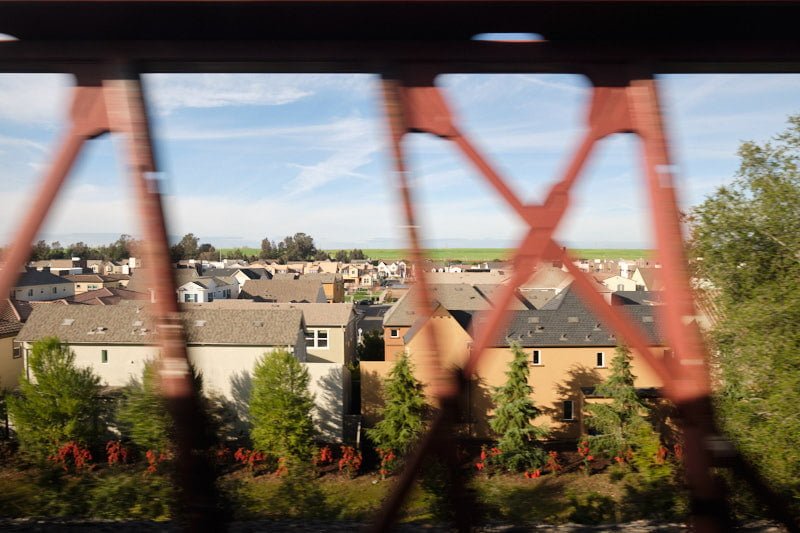Disclosure: This post may contain affiliate links. I earn a small commission of product sales to keep this website going.
One of the key advantages of mirrorless cameras over DSLRs is their small size and quiet operation. They’re already much quieter than traditional DSLRs, and when you use their silent shutter they’re 100% inaudible. But there are some electronic shutter disadvantages that every photographer should be aware of before making it their default setting.
I will be using the term “electronic shutter” to refer to the pure electronic shutter for the purposes of silent shooting, not electronic front curtain or any combinations thereof.
Mechanical shutters vs Electronic shutters
First we need to understand how mechanical and electronic shutters work.
Mechanical shutters
Mechanical shutters protect film in traditional film cameras – a curtain, if you will. One curtain opens to reveal the film and another curtain quickly follows to cover it. Shutter speed is the time the film is exposed to light.
Standard shutters in digital cameras operate the same way but have a digital sensor behind them in place of the film.
And like film, the natural state of the sensor is always “on”.

Due to mechanical limitations, mechanical shutter speeds can only go so fast. On the Fujifilm X-T3, for example, the maximum mechanical shutter speed is 1/8000 sec. Still pretty damn fast!
Electronic shutters
But technology allows us to manipulate the sensor digitally, something we couldn’t do with film in-camera. This allows us to get shutter speeds of 1/32000 sec. on that same camera!
Here’s how an electronic shutter works:
- The mechanical curtain is out of the way and the sensor is on, but not recording.
- You press the shutter button.
- Each individual pixel sensor is turned “off,” one row at a time.
- Those pixels are then turned back “on” for the preset time (shutter speed).
- The pixel is then turned back “off,” and the light read during that brief “on” time is recorded.
- Those pixels are then turned back “on” to their natural state, but not recording, when the exposure is complete.
That’s the most simplified way of describing the digital circus happening at the time. Again, this process happens row-by-row in a cascading manner.

But hold on…
How much time does it really take?
With a mechanical shutter, the sensor stays on and is only exposed to light for the time the curtains are open (your shutter speed). When your shutter speed is 1/500 sec., this entire process happens pretty close to 1/500 sec., only adding the time it takes for those curtains to fly over the shutter.
When an electronic shutter is used, each pixel row is exposed to light for that same 1/500 sec. But because each pixel row is turned off & on one row at a time, the entire process can take as much as 1/10 sec. from the beginning of the exposure to the end, dependent on the camera’s processing power.
Now imagine that you’re in a fast-moving train. You’re using the electronic shutter so you don’t advertise all the photos you’re taking. A train passes on parallel tracks going the opposite direction and you take a photo at 1/500 sec.
A mechanical shutter would show some slight motion blur, kinda like what your eyes register, because the entire image is made in 1/500 sec.
But there’s some serious electronic shutter distortion because the entire process is taking 1/10 sec., not 1/500 sec., when that electronic shutter is used.
This is exactly what happened to me, as you can see in this photo. It’s a perfect illustration of how the light is recorded one row at a time as this train is moving past at a combined speed of 150+ mph. Lines that should be near vertical are actually very diagonal.

Disadvantages with Electronic Shutter silent shooting
Hopefully, the above photo helps you understand what’s happening when the electronic shutter is used. Now here’s what those disadvantages are.
Electronic shutter distortion
This is the most obvious disadvantage of electronic shutters, as seen in the above photo. Moving objects – cars, propellers, and even people – can look wobbly when using an electronic shutter.
Because, remember, an electronic shutter speed of 1/2000, for example, can actually take up to 1/10 seconds for the entire exposure.
The effect is less noticeable the slower those objects are moving, but speed things up and it’s really obvious.
This is also called “rolling” effect.

Electronic shutter flash limitations
Forget it – you can’t use flash with an electronic shutter, in most cameras, for now.
Your flash options will most likely be disabled in your camera when the electronic shutter is enabled (as with Fujifilm and Sony mirrorless cameras, for example).
Speedlights only have one “brightness”; the power/exposure of a flash is actually dictated by its burst time, which is typically around 1/400 sec. at the most powerful setting. Imagine leaving that light on for 1/10 sec. – you’d burn it out in no time and whitewash everything!
Fluorescent lighting
Some funny things happen when using an electronic shutter under fluorescent lighting.
Fluorescent lights are not continuously “on.” They actually cycle at either 50 or 60 cycles per second, depending on your country’s power grid.
This can produce some obvious bands across your photo. One row of pixels is recorded when the fluorescent light is on while the next is recorded as the light cycles off.

Camera-dependent features disabled
There may be some other features on your camera that aren’t available when the electronic shutter silent shooting mode is enabled.
It would be too exhaustive to list every model here; do some research so you’re not surprised to find something unavailable when it matters.
When to use Electronic Shutter
Some may see it as a marketing gimmick – and to some extent, it is because the disadvantages of electronic shutters are not readily disclosed. Manufacturers only tout the amazing “silent shooting mode.”
But when you do need silence, such as during speeches, wildlife photography, or when you don’t want to draw attention to yourself, completely silent electronic shutters are a great tool.
Just remember the following when using an electronic shutter for silent shooting:
- Ensure minimal movement
- Flash won’t be available
- Fluorescent lighting may produce banding
- Silence other features such as focus-lock beeps; your lens autofocus motor is also a limitation
- Know your camera!
Use this feature sparingly, only when you need to. I’ve programmed a custom button on all my Fujifilm cameras to enable/disable this mode so I can toggle it on-the-fly. When the conditions are right it’s an amazing feature!
Technological advances may soon introduce us to the “global electronic shutter”, which means that the entire sensor is read out at the same time. When that day comes these limitations will largely disappear.
There is another technology found in some cameras, an Electronic Front Curtain Shutter, that attempts to maintain the advantages of the MS and ES but without most of the disadvantages. You can read more about the Electronic Front Curtain Shutter here.

Svetlana Grobman
Sunday 16th of February 2020
This is definitely very well explained, but I have a question. The settings on my X-T2 allow me to combine both electronic and mechanical shutter (that is how I have it programmed in my Q menu). Is there anything wrong with that?
Thanks
John Peltier
Monday 17th of February 2020
Hi Lana, great question. There's nothing "wrong" with that per se, as long as you're aware of your limitations when you go into MS+ES. I think flash is disabled, exposures longer than 4s are disabled, and if you're doing burst shooting the focus and exposure are locked in the first photo of the burst. Welcome to the Mirrorless Camera course, by the way! Please don't hesitate to send me an email if you have any other questions about anything.
Adam
Wednesday 10th of April 2019
As I was reading this (it's great btw), I wondered why with the electronic shutter, pixels are turned on/off one row at a time... it would have made more sense if they started with the whole sensor in one go (as you later mention "global"), kinda like it presumably does with the mechanical shutter. Any reason why it does it row by row? I never see it mentioned in new camera releases - is there any advantage of doing things row-by-row vs. global?
John Peltier
Wednesday 10th of April 2019
Hi Adam, thanks for the feedback. There are certainly no advantages to the rolling shutter, other than it's all that consumer cameras can afford to have in them right now. It all has to do with how fast the sensor readout can physically happen. More expensive (really expensive) cameras have CCD sensors and those have a global shutter - the readout happens all at once. But consumer cameras have CMOS sensors, which are cheap & easy to produce, but the readout happens slower, hence rolling shutter. Physicists are working on a global shutter for consumer cameras but it may be a while.